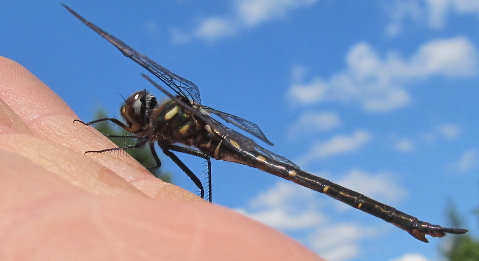I’ve been seeing a lot more aphids in northern Minnesota than I can ever recall seeing before, especially on Solidago (goldenrod). I don’t know if there are really more than normal or if I’m just seeing them because I’m looking for lady beetles. If there’s one thing most lady beetles like, its aphids. If you find an abundance of aphids somewhere, you can usually count on some lady beetles showing up shortly to feast on them. Both adults and larvae will devour many of the plump, soft-bodied aphids in one day. With the abundance I’m seeing, there should be a lot of lady beetles showing up soon. The problem is they will be mostly the wrong ones.
I’ve also been finding a lot of lady beetle larvae and pupae at one particular patch of wildflowers in west Duluth, and almost all of them have been pupae of Coccinella septempunctata, or 7-spotted lady beetle. Although native to Europe and Asia, by the end of August each summer they outnumber most or all of our native species.



Pupa, larva and adult of Coccinella septempunctata. Do aphids hear the Jaws theme when they see this coming?
While disappointing, it won’t be very surprising. Along with its fellow invasives Harmonia axyridis and Hippodamia variegata, C. septempunctata has been increasing in the region ever since it first appeared some 20-25 years ago. When I conducted lady beetle surveys at nearly 70 northern Minnesota sites in 2014, 7-spotteds were found in nearly twice as many samples as any native species. As I walk through this patch of roadside flowers for hundreds of feet on July 31, I don’t see any other species.
The next day I visited another small patch of wildflowers in the heart of Duluth. Initially, I found the exact same thing, aphids everywhere but only 7-spotted lady beetles. Finally I spotted something different, a species of Hippodamia! We have at least 6 native species of Hippodamia in Minnesota, but I soon realized this wasn’t one of them. It was H. variegata, the variegated lady beetle. This is the most recent unwelcome addition to our lady beetle fauna, spreading through the western Great Lakes states by the early 2000s. By all indications it is still on the increase in Minnesota; it was the third most frequently encountered species in my 2014 surveys, more common than all but one native species.

Hippodamia variegata, Duluth, MN. August 1 2017
I didn’t have to look too much longer before I found the third and most well-known of our invasive lady beetles. Most people are all too familiar with the Harmonia axyridis, the multi-colored Asian lady beetle that invades homes and cabins in large numbers and makes a rather unpleasant house guest. They fly into lights and emit foul-smelling chemicals that also foul crops like grapes. They are large enough to deliver a noticeable pinch with their mandibles when handled. Along with Coccinella septempunctata they have been linked to the decline of several native lady beetles across eastern North America and all of Minnesota. Adalia bipunctata, Coccinella novemnotata and Coccinella transversogutta (2-spotted, 9-spotted and transverse lady beetles, respectively) have all declined severely in Minnesota, but we recently found that Hippodamia convergens (convergent lady beetle) has also declined.
We still have dozens of native lady beetle species in Minnesota, (most people think there are only 2 kinds: red and orange!) but it’s hard to say what the future will look like for native species. There are definitely more adventive species knocking at the door. Propylea quatuordecimpunctata is one such species. It has been found in Wisconsin but so far has not been reported from Minnesota. Others are almost certain to follow.
Koch, R.L. 2011. Recent detections of a rare native lady beetle, Coccinella novemnotata
Herbst (Coleoptera: Coccinellidae), in Minnesota. The Great Lakes Entomologist 44(3-
4): 196-199.
Steffens, W. P. 2015. Rare Tiger Beetle and Lady Beetle Surveys in Minnesota’s Lake Superior Coastal Zone. Report to Minnesota’s Lake Superior Coastal Program. Project No. 13-306-05C. 25 p.
Steffens, W.P., R.P., Lumen. 2015. Decline in relative abundance of Hippodamia
convergens (Coleoptera: Coccinellidae) in fall shoreline aggregations on western Lake
Superior. The Great Lakes Entomologist 48: 159-162.
Steffens, W. P. and C. Little. 2014. Ladybugs of Minnesota Poster. Created for Minnesota’s Lake Superior Coastal Program Project No. 13-306-05C. 25 p.
Williams, A.H., and D.K. Young. 2009. The alien Hippodamia variegata (Coleoptera: Coccinellidae) quickly establishes itself throughout Wisconsin. The Great Lakes Entomologist 42: 100.
©2017 Wayne P. Steffens
